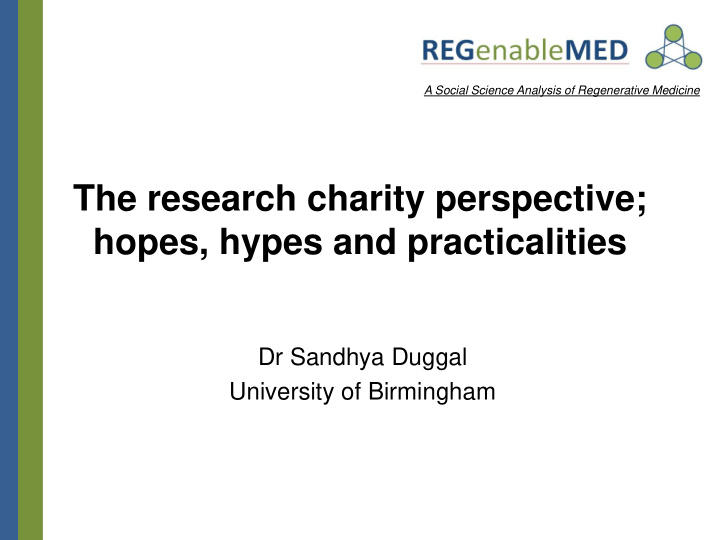



A Social Science Analysis of Regenerative Medicine The research charity perspective; hopes, hypes and practicalities Dr Sandhya Duggal University of Birmingham
Background • Why research charities? • Intermediary position between scientists and patients • Pathways to clinic • Little inquiry into their expectations
Background • Areas of RM activity British Heart Foundation – RM and cardiovascular research. Funding around £38m in the UK. A new research programme - Mending Broken Hearts Alzheimer’s Research UK – iPSC derived human neurons as models and for in vitro models of pathology. Three drug discovery institutes at Oxford, Cambridge and UCL. Fight 4 Sight – investment into Retinitis pigmentosa and Stargardt Disease, ‘ Fulbright Fight for Sight Research Award ’
Methodology • Interviews with 9 medical research charities: Neurological Autoimmune Dermatology Cardiovascular Ophthalmology Parkinson's UK JDRF DEBRA British Heart Fight 4 Sight Foundation Scottish Huntington's Association MS Society Alzheimer's UK Motor Neurone Disease Association
Findings • Managing media expectations • Disease specific appropriateness of RM • Future success of conditions
Managing media expectations • Media rhetoric of promise • Narratives of hype characterised by timespan • Reframing public expectations “I think it’s important that those results see the light of day, but it’s just the way it sometimes gets presented, I think, that it’s good if organisations such as ours can help try and, you know, temper some of that”
Disease-specific appropriateness of RM • RM and varied ‘compatibility’ to disease areas “ (T1D) - it’s a perfect disease for RM because you absolutely know your cells and you know that if you put them in they’re going to have an effect. It’s a bit like Parkinson’s - it’s known that if you were able to replace those cells you would actually be able to have an effect on the disease. So there are some diseases that it’s really appropriate for” “ So rewiring the nervous system is, frankly, science fiction when it comes to conditions like Motor Neurone Disease. It might have more relevance in focal degenerative conditions, let’s say, like stroke or maybe Parkinson’s Disease”
Expectations of future success conditions • Practical and theoretical developments needed for RM success • ‘De - risking’ for future investment “So if we can change that balance, make it less risky , hopefully, that would bring new investment and new trials and more drive to find RM therapies for Parkinson’s. At the moment it’s quite a difficult environment for people who are looking for those new drugs and encouraging pharmaceutical companies to really try new, innovative treatments”
Conclusion • Balancing act - hope and hype • RM for diseases or diseases for RM? • De-risking RM • Pathways to clinic
Thank you • Questions
Recommend
More recommend